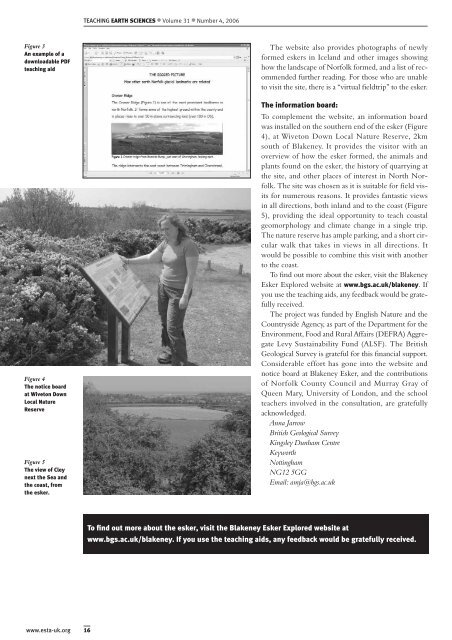teaching - Earth Science Teachers' Association
teaching - Earth Science Teachers' Association
teaching - Earth Science Teachers' Association
Create successful ePaper yourself
Turn your PDF publications into a flip-book with our unique Google optimized e-Paper software.
TEACHING EARTH SCIENCES ● Volume 31 ● Number 4, 2006<br />
Figure 3<br />
An example of a<br />
downloadable PDF<br />
<strong>teaching</strong> aid<br />
Figure 4<br />
The notice board<br />
at Wiveton Down<br />
Local Nature<br />
Reserve<br />
Figure 5<br />
The view of Cley<br />
next the Sea and<br />
the coast, from<br />
the esker.<br />
The website also provides photographs of newly<br />
formed eskers in Iceland and other images showing<br />
how the landscape of Norfolk formed, and a list of recommended<br />
further reading. For those who are unable<br />
to visit the site, there is a “virtual fieldtrip” to the esker.<br />
The information board:<br />
To complement the website, an information board<br />
was installed on the southern end of the esker (Figure<br />
4), at Wiveton Down Local Nature Reserve, 2km<br />
south of Blakeney. It provides the visitor with an<br />
overview of how the esker formed, the animals and<br />
plants found on the esker, the history of quarrying at<br />
the site, and other places of interest in North Norfolk.<br />
The site was chosen as it is suitable for field visits<br />
for numerous reasons. It provides fantastic views<br />
in all directions, both inland and to the coast (Figure<br />
5), providing the ideal opportunity to teach coastal<br />
geomorphology and climate change in a single trip.<br />
The nature reserve has ample parking, and a short circular<br />
walk that takes in views in all directions. It<br />
would be possible to combine this visit with another<br />
to the coast.<br />
To find out more about the esker, visit the Blakeney<br />
Esker Explored website at www.bgs.ac.uk/blakeney. If<br />
you use the <strong>teaching</strong> aids, any feedback would be gratefully<br />
received.<br />
The project was funded by English Nature and the<br />
Countryside Agency, as part of the Department for the<br />
Environment, Food and Rural Affairs (DEFRA) Aggregate<br />
Levy Sustainability Fund (ALSF). The British<br />
Geological Survey is grateful for this financial support.<br />
Considerable effort has gone into the website and<br />
notice board at Blakeney Esker, and the contributions<br />
of Norfolk County Council and Murray Gray of<br />
Queen Mary, University of London, and the school<br />
teachers involved in the consultation, are gratefully<br />
acknowledged.<br />
Anna Jarrow<br />
British Geological Survey<br />
Kingsley Dunham Centre<br />
Keyworth<br />
Nottingham<br />
NG12 5GG<br />
Email: amja@bgs.ac.uk<br />
To find out more about the esker, visit the Blakeney Esker Explored website at<br />
www.bgs.ac.uk/blakeney. If you use the <strong>teaching</strong> aids, any feedback would be gratefully received.<br />
www.esta-uk.org<br />
16

















